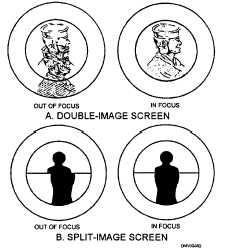Cameras, Continued
Camera
adjustments
Each of the three parallel planes of a camera has further adjustments to
control the size, sharpness, brightness, and contrast of images. Scales
control ‘image size. Focus and aperture rings, along with shutter speed and
film speed dials, control image resolution.
SCALES: Scales on process and copy cameras control percentages of
reduction or enlargement. Most of these cameras reduce to 50% and enlarge
to 300%, or any range in between. Scales are usually located on the head of
process and copy cameras.
FOCUSING CONTROL: Except for cheaply made cameras, most cameras
can focus or adjust the sharpness of images striking the film or focal plane.
Images on the ground glass of copy or process cameras appear fuzzy until
you rotate the handwheels or cranks of the three planes. You may need a
loup or magnifier to focus sharply. On small adjustable cameras, the image
appears in the viewfinder as a ghost or double image, or as broken images
that you align into one image. To align images, rotate a sleeve on the lens
until the two images appear superimposed (directly on top of the other).
Specialty focusing screens, such as hairlines and grids, are available to
accommodate individual preferences.
Figure 7-2 illustrates the most common focusing screen images.
Figure 7-2.—Common focusing
screens: A. Double-image; B.
Split-image.
Continued on next page
7-6

